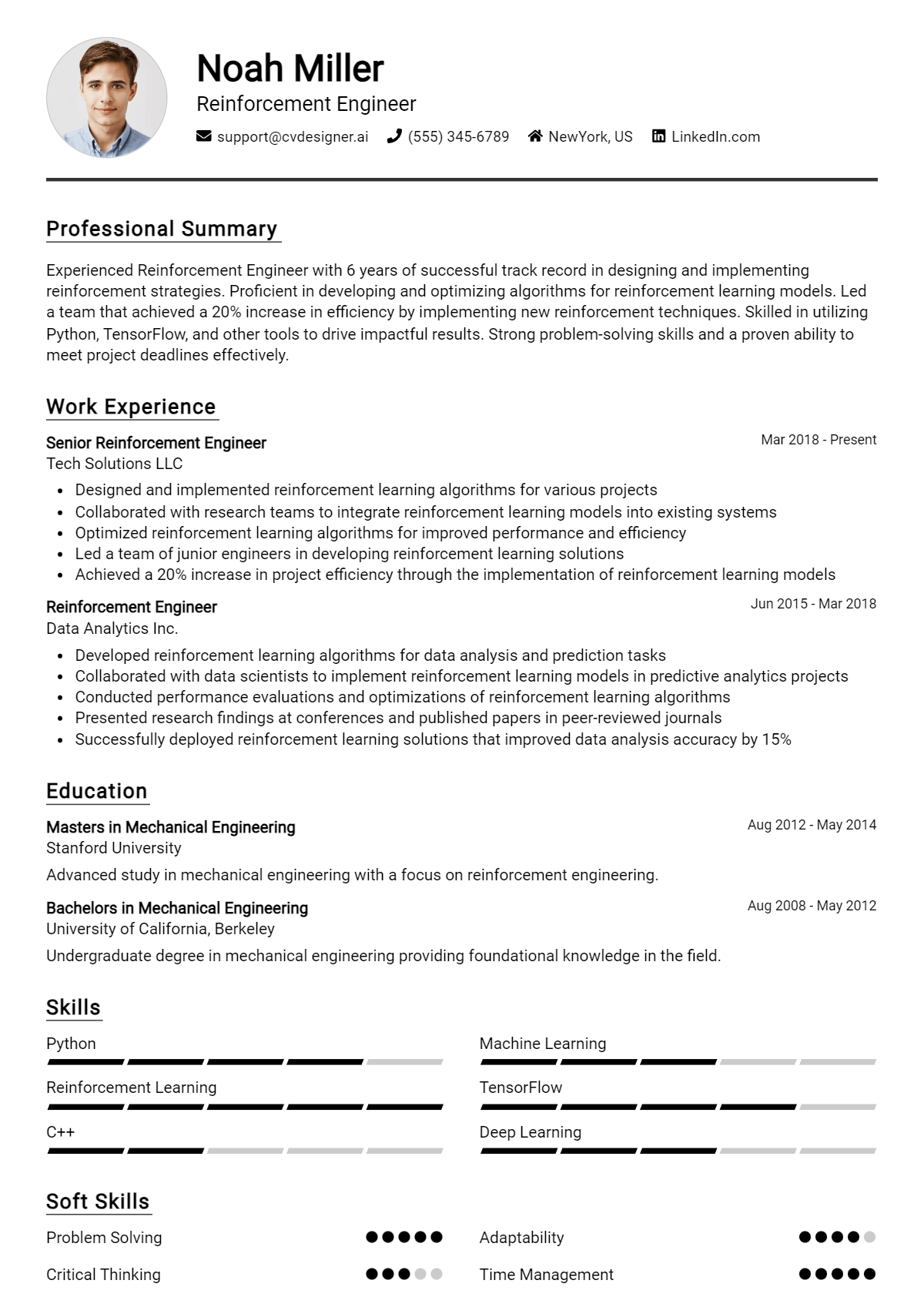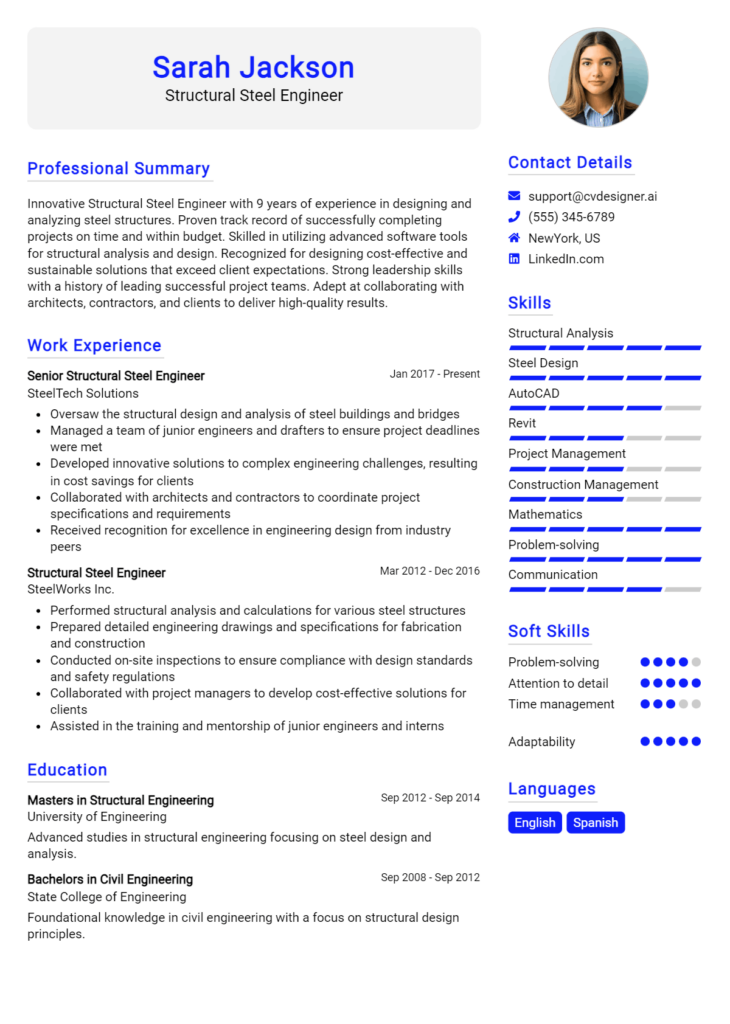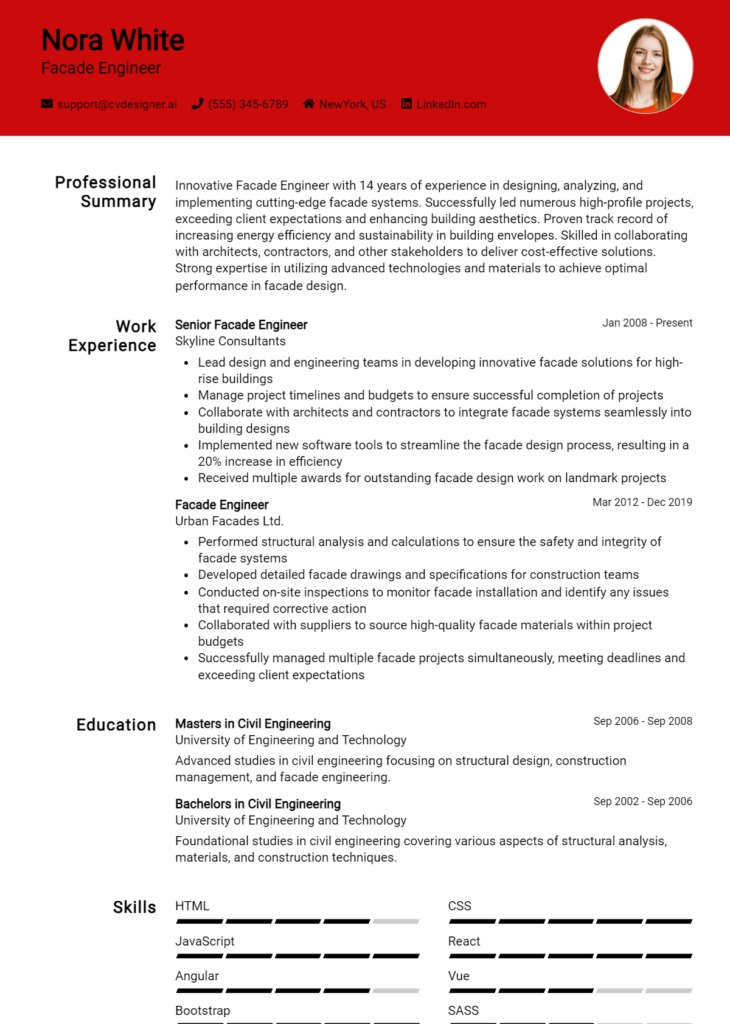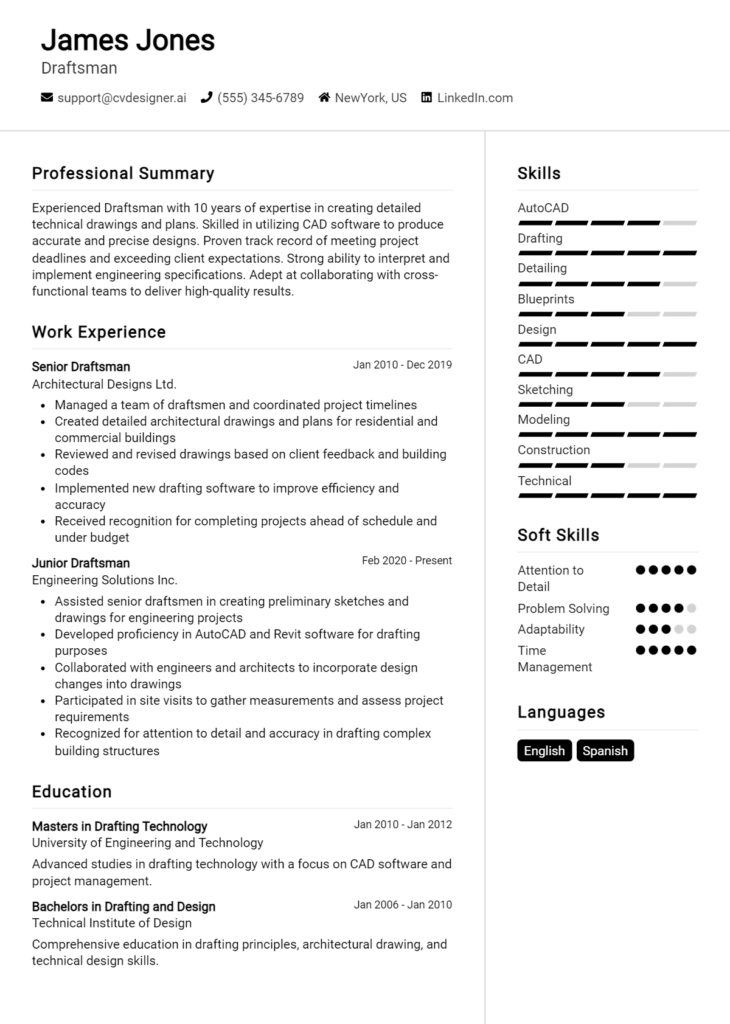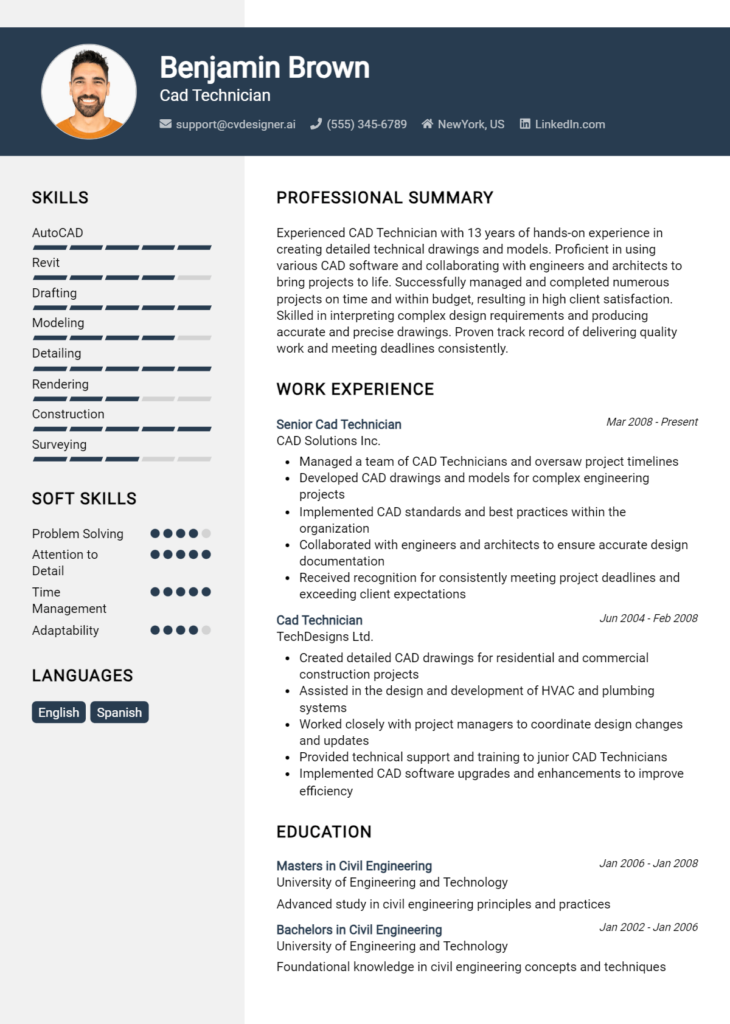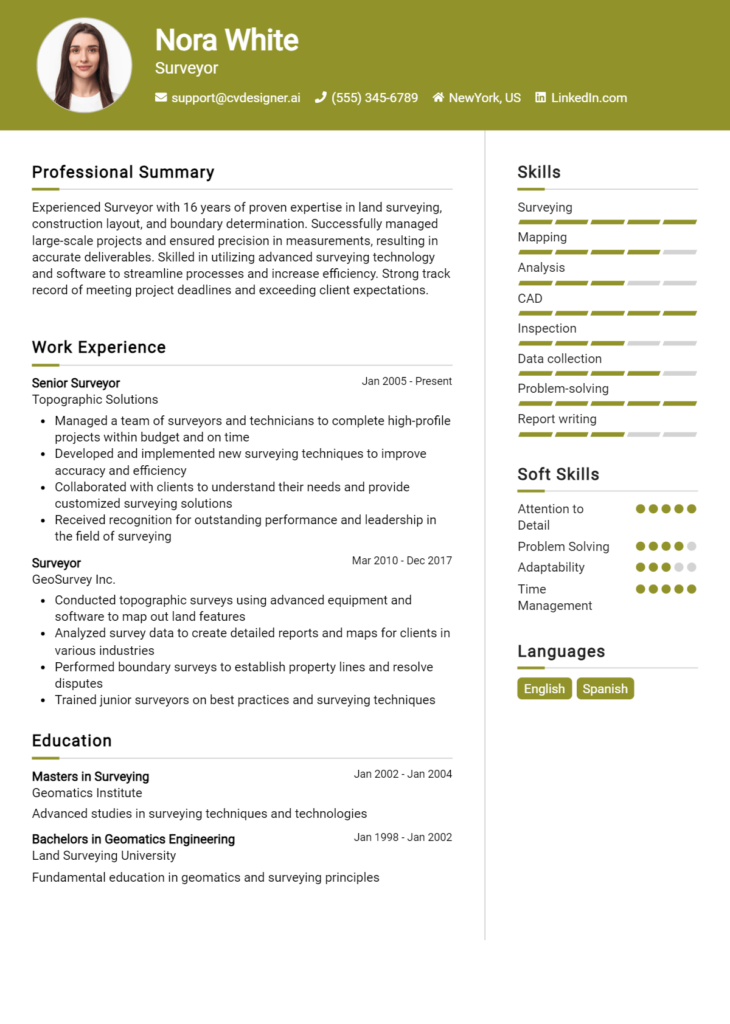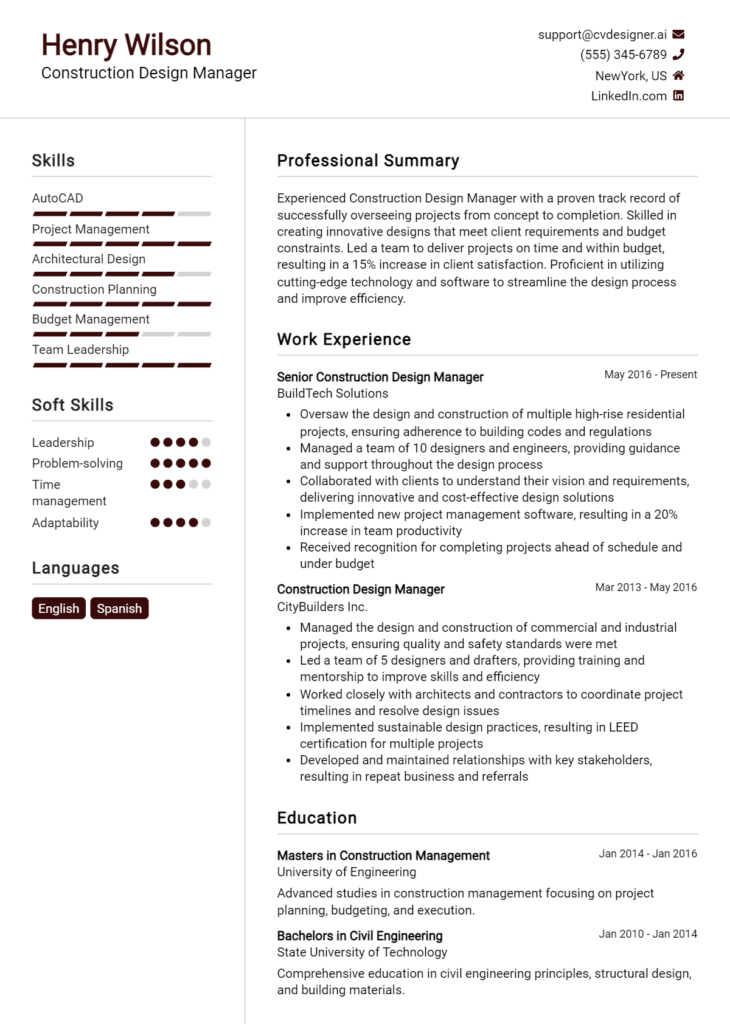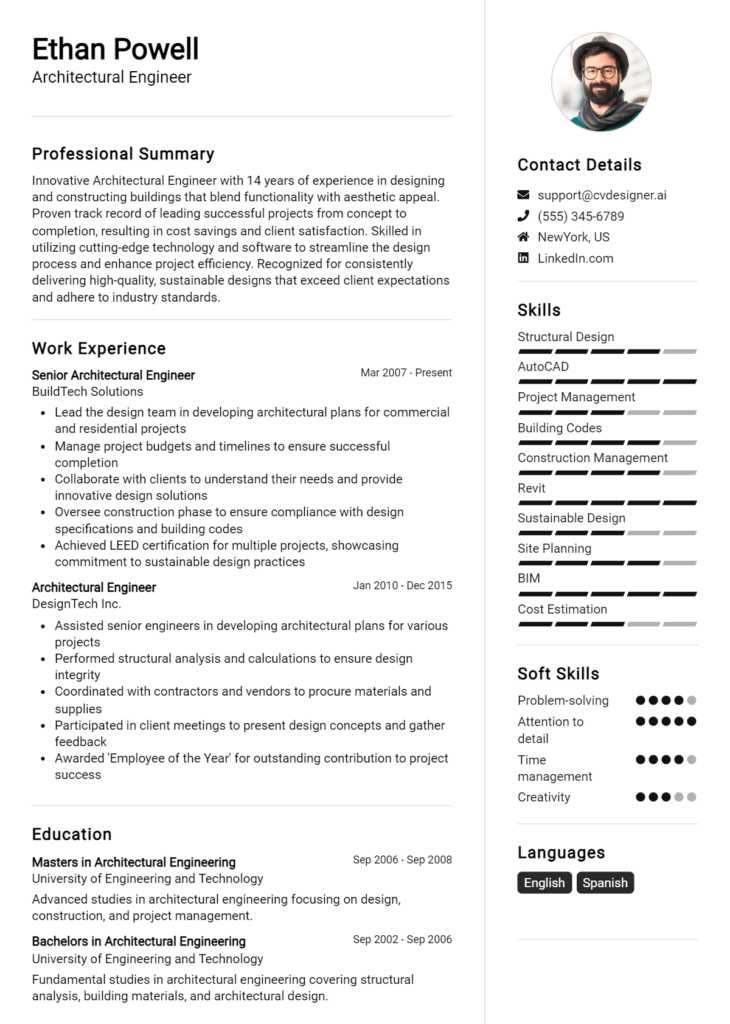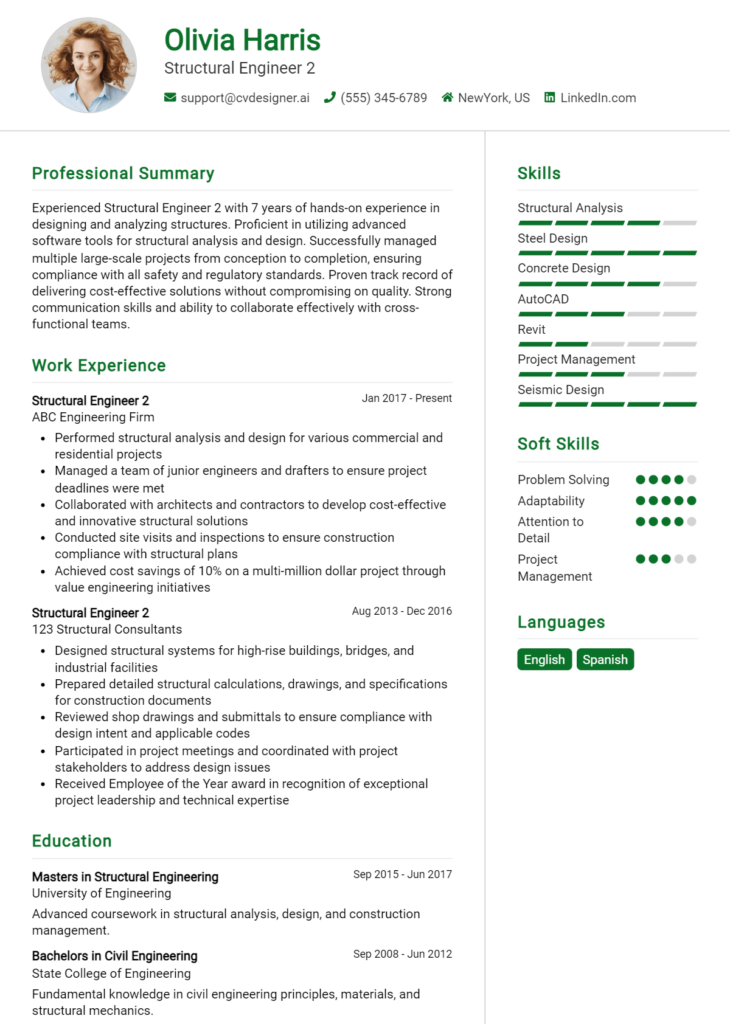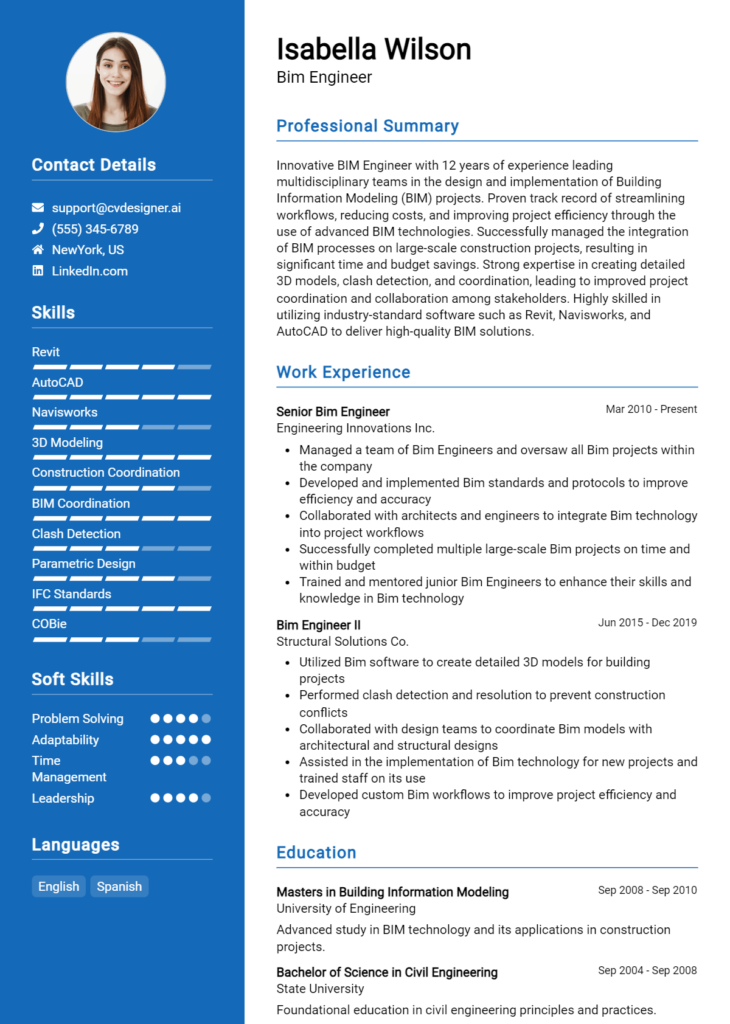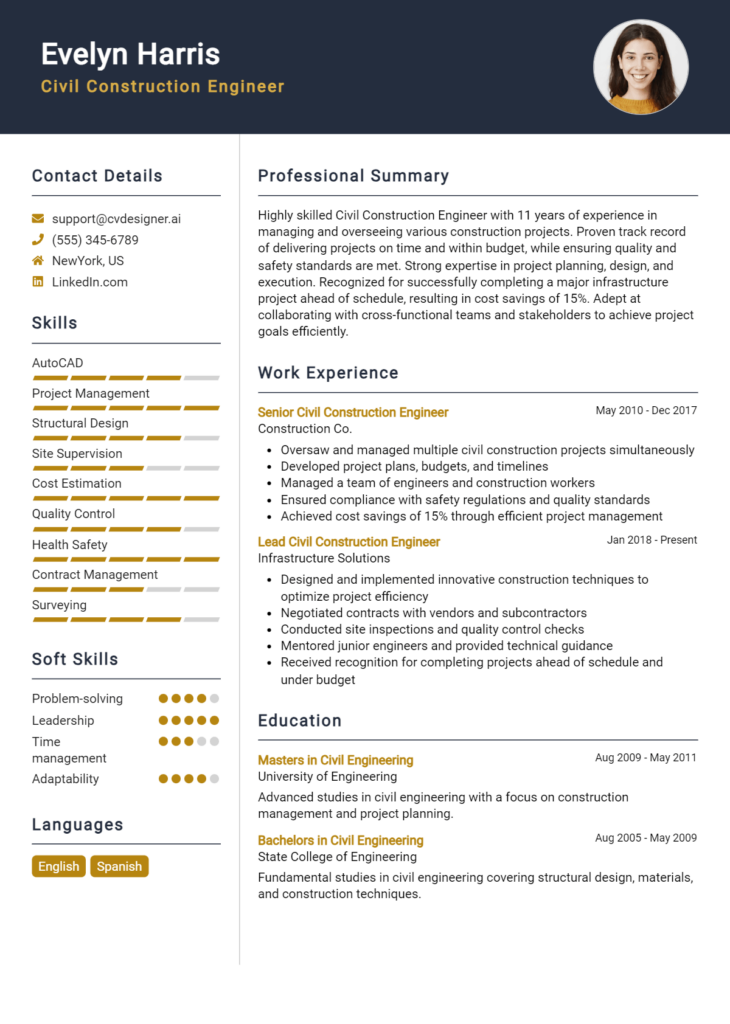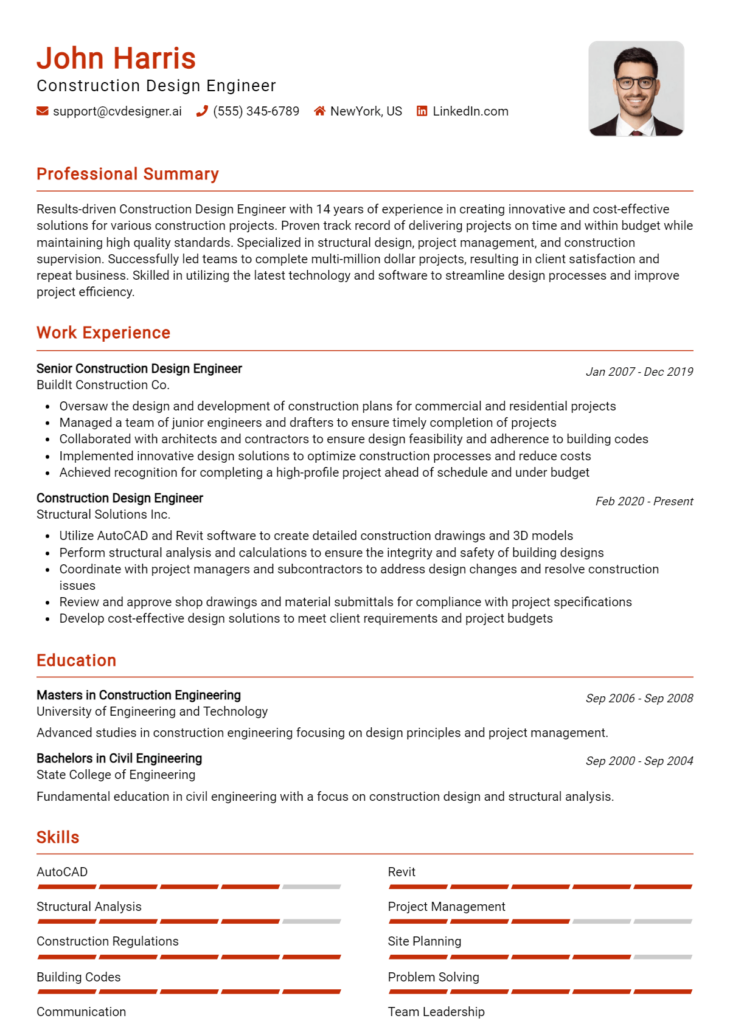Reinforcement Engineer Core Responsibilities
A Reinforcement Engineer plays a crucial role in the design and implementation of structural reinforcements, ensuring safety and durability in construction projects. Key responsibilities include analyzing structural integrity, collaborating with architects and construction teams, and developing reinforcement plans that meet safety standards. Essential skills encompass strong technical knowledge, operational insight, and advanced problem-solving abilities. These competencies are vital in achieving organizational goals, and a well-structured resume can effectively highlight these qualifications, showcasing the candidate's value to potential employers.
Common Responsibilities Listed on Reinforcement Engineer Resume
- Analyze structural designs to determine reinforcement needs.
- Collaborate with architects to develop integrated reinforcement solutions.
- Create detailed reinforcement specifications and drawings.
- Conduct site inspections to monitor compliance with reinforcement plans.
- Perform load calculations and simulations to ensure safety standards.
- Develop and oversee testing procedures for reinforcement materials.
- Provide technical support during construction phases.
- Identify and resolve structural issues in existing designs.
- Stay updated on industry standards and regulations.
- Prepare and present project documentation and reports.
- Collaborate with multidisciplinary teams to optimize project outcomes.
- Mentor junior engineers and provide training on reinforcement techniques.
High-Level Resume Tips for Reinforcement Engineer Professionals
In today's competitive job market, a well-crafted resume is essential for Reinforcement Engineer professionals aiming to make a lasting impression on potential employers. Your resume often serves as the first point of contact between you and your future employer, making it crucial to present a polished and compelling document that reflects your skills and accomplishments. A strong resume can effectively showcase your technical expertise, project experience, and industry knowledge, setting you apart from the competition. This guide will provide practical and actionable resume tips specifically tailored for Reinforcement Engineer professionals, ensuring that your resume captures the attention of hiring managers and effectively highlights your qualifications.
Top Resume Tips for Reinforcement Engineer Professionals
- Tailor your resume to the job description, emphasizing keywords and phrases that align with the specific requirements of the position.
- Highlight relevant experience by detailing past projects, including the scope of work, your role, and the outcomes achieved.
- Quantify your achievements with metrics, such as cost savings, efficiency improvements, or successful project completions, to demonstrate your impact.
- Showcase your technical skills by listing proficiency in industry-specific software, tools, and methodologies relevant to reinforcement engineering.
- Include certifications and licenses that enhance your qualifications and demonstrate your commitment to professional development.
- Utilize a clear and professional format, with consistent font styles and sizes, to ensure readability and presentability.
- Incorporate a summary statement at the top of your resume that succinctly encapsulates your experience, skills, and career goals.
- Emphasize teamwork and collaboration skills, as reinforcement engineering often involves working with diverse teams on complex projects.
- Keep your resume concise, ideally one page, while ensuring that all relevant information is presented without unnecessary fluff.
- Proofread for errors and typos, as attention to detail is critical in engineering roles and can reflect your professionalism.
By implementing these tips, you can significantly enhance your chances of landing a job in the Reinforcement Engineer field. A well-structured and tailored resume not only showcases your qualifications but also demonstrates your understanding of the industry and your commitment to excellence, making you a more attractive candidate to potential employers.
Why Resume Headlines & Titles are Important for Reinforcement Engineer
In the competitive field of engineering, particularly for specialized roles like a Reinforcement Engineer, crafting an effective resume is crucial. One of the key elements of a successful resume is the headline or title, which serves as the first impression for hiring managers. A strong headline can immediately grab attention and succinctly summarize a candidate's key qualifications, making it easier for recruiters to assess their fit for the position. This headline should be concise, relevant, and directly aligned with the job being applied for, ensuring that it resonates with the specific requirements of the role.
Best Practices for Crafting Resume Headlines for Reinforcement Engineer
- Keep it concise, ideally under 10 words.
- Use keywords relevant to the Reinforcement Engineer role.
- Highlight specific technical skills or certifications.
- Incorporate quantifiable achievements when possible.
- Avoid vague language; be specific about your expertise.
- Tailor the headline for each job application.
- Use action-oriented language to convey confidence.
- Focus on what sets you apart from other candidates.
Example Resume Headlines for Reinforcement Engineer
Strong Resume Headlines
Innovative Reinforcement Engineer with 10+ Years of Experience in Structural Design
Expert Reinforcement Specialist Skilled in Advanced Material Analysis and Modeling
Results-Driven Reinforcement Engineer with Proven Track Record in Project Management
Certified Reinforcement Engineer with Expertise in Sustainable Construction Practices
Weak Resume Headlines
Engineer Looking for Job
Experienced Professional
Reinforcement Engineer
The strong headlines are effective because they clearly communicate the candidate's expertise and specific achievements, immediately giving hiring managers insight into their qualifications. They incorporate relevant keywords and highlight unique strengths, making them more likely to catch attention. In contrast, the weak headlines fail to impress due to their vagueness and lack of specific information, leaving hiring managers without a clear understanding of the candidate’s capabilities or how they align with the job requirements.
Writing an Exceptional Reinforcement Engineer Resume Summary
A well-crafted resume summary is vital for a Reinforcement Engineer as it serves as the first impression a hiring manager will have of a candidate. A strong summary effectively captures attention by succinctly showcasing key skills, relevant experience, and notable accomplishments that align with the specific demands of the job role. It should be concise, impactful, and tailored to the job description, enabling candidates to stand out in a competitive job market and encouraging further examination of their qualifications.
Best Practices for Writing a Reinforcement Engineer Resume Summary
- Quantify Achievements: Use numbers and metrics to highlight your successes, such as "Increased structural integrity by 30% through innovative design solutions."
- Focus on Relevant Skills: Highlight skills that are directly applicable to the role, such as proficiency in CAD software, knowledge of building codes, or experience with specific reinforcement materials.
- Tailor to the Job Description: Customize your summary for each application by incorporating keywords and phrases found in the job listing.
- Keep it Concise: Aim for 3-5 sentences that succinctly convey your experience and value without unnecessary filler.
- Highlight Key Accomplishments: Mention significant projects or contributions that demonstrate your expertise and impact in previous roles.
- Use Action-Oriented Language: Start sentences with strong action verbs to convey confidence and initiative.
- Showcase Certifications or Specializations: If applicable, mention any relevant certifications or areas of specialization that could set you apart from other candidates.
- Maintain a Professional Tone: Ensure your summary reflects professionalism and aligns with the industry's standards.
Example Reinforcement Engineer Resume Summaries
Strong Resume Summaries
Results-driven Reinforcement Engineer with over 5 years of experience in optimizing structural designs. Successfully led a project that improved load-bearing capacity by 25%, resulting in significant cost savings for the client. Proficient in AutoCAD and Revit, with a deep understanding of material science.
Detail-oriented Reinforcement Engineer with expertise in seismic design and retrofitting. Developed innovative reinforcement solutions that enhanced building resilience by 40% during vulnerability assessments. Certified in Structural Engineering and experienced in project management.
Dynamic Reinforcement Engineer with a background in high-rise construction projects. Spearheaded a team that reduced project timelines by 15% through efficient reinforcement strategies. Strong knowledge of current building codes and standards.
Weak Resume Summaries
Experienced engineer looking for opportunities in reinforcement.
Skilled in various engineering tasks and interested in structural projects.
The examples of strong resume summaries are considered effective because they are specific, quantify achievements, and directly relate to the responsibilities of a Reinforcement Engineer. They provide clear evidence of the candidate's impact and expertise, making them memorable to hiring managers. In contrast, the weak summaries lack detail and measurable outcomes, making it difficult for employers to gauge the candidates' qualifications or fit for the role. They are too generic and do not showcase the unique strengths of the applicants.
Work Experience Section for Reinforcement Engineer Resume
The work experience section of a Reinforcement Engineer resume is crucial as it serves as a testament to the candidate's technical capabilities, leadership qualities, and ability to produce high-quality results. This section provides potential employers with a clear insight into how the candidate has applied their engineering skills in real-world scenarios, managed teams effectively, and contributed to successful project outcomes. By quantifying achievements and ensuring that the experience aligns with industry standards, candidates can demonstrate their value and readiness to take on challenging roles in reinforcement engineering.
Best Practices for Reinforcement Engineer Work Experience
- Highlight specific technical skills relevant to reinforcement engineering, such as structural analysis and material science.
- Quantify achievements with metrics, such as project timelines, cost savings, or efficiency improvements.
- Use action verbs to describe previous roles, emphasizing leadership and collaboration.
- Tailor your experience to align with the job description and industry standards.
- Incorporate successful project examples that showcase problem-solving capabilities.
- Include interdisciplinary collaboration experiences to demonstrate teamwork in engineering projects.
- Detail certifications or specialized training that enhance your qualifications.
- Focus on continuous improvement initiatives that showcase innovation and forward-thinking.
Example Work Experiences for Reinforcement Engineer
Strong Experiences
- Led a team of 5 engineers in the design and implementation of a reinforced concrete bridge, completing the project 15% under budget and two weeks ahead of schedule.
- Developed a new reinforcement methodology that improved the structural integrity of existing buildings, resulting in a 30% reduction in material costs.
- Collaborated with architects and contractors on a high-rise project, enhancing building performance while ensuring compliance with safety regulations, leading to zero incidents reported.
- Successfully managed multiple reinforcement projects, delivering 95% of them on time and receiving commendations from stakeholders for quality and efficiency.
Weak Experiences
- Worked on various engineering projects without specific roles or contributions mentioned.
- Assisted in team tasks; details on impact or results were not provided.
- Participated in meetings and discussions about reinforcement engineering without demonstrating technical input.
- Involved in project planning without quantifying any achievements or contributions to project success.
The examples listed as strong experiences are characterized by specific achievements, quantifiable results, and clear leadership roles, showcasing a candidate's ability to deliver significant contributions to projects. In contrast, the weak experiences lack detail and measurable outcomes, failing to demonstrate the candidate's technical expertise or impact in their roles. By focusing on strong experiences, candidates can better position themselves as valuable assets to potential employers in the field of reinforcement engineering.
Education and Certifications Section for Reinforcement Engineer Resume
The education and certifications section of a Reinforcement Engineer resume plays a crucial role in showcasing the candidate's academic credentials, relevant industry certifications, and commitment to ongoing professional development. This section not only highlights the foundational knowledge acquired through formal education but also emphasizes the candidate's dedication to staying current with industry standards and innovations. By providing details about relevant coursework, certifications, and any specialized training, candidates can significantly enhance their credibility and demonstrate their alignment with the specific requirements of the job role.
Best Practices for Reinforcement Engineer Education and Certifications
- Include only relevant degrees and certifications that pertain to reinforcement engineering.
- Use clear headings and bullet points for easy readability and quick reference.
- Highlight advanced degrees (Master's or Ph.D.) or specialized certifications that showcase expertise.
- List certifications from recognized industry bodies to enhance credibility.
- Provide details about relevant coursework that aligns with the job requirements.
- Include the dates of completion for certifications to demonstrate recent learning.
- Emphasize any continuing education or professional development activities.
- Keep the section concise and focused on the most significant qualifications.
Example Education and Certifications for Reinforcement Engineer
Strong Examples
- B.S. in Civil Engineering, University of Technology, 2020
- Certified Reinforcement Engineer (CRE), National Association of Structural Engineers, 2021
- Advanced Reinforcement Techniques Course, American Concrete Institute, 2022
- M.S. in Structural Engineering, University of Science, 2022
Weak Examples
- B.A. in History, University of Arts, 2019
- Basic First Aid Certification, 2020
- Online Course in Graphic Design, 2021
- High School Diploma, 2015
The strong examples are considered relevant because they directly pertain to the field of reinforcement engineering, showcasing both the educational background and industry-recognized credentials that align with the demands of the role. In contrast, the weak examples lack relevance, either because the degrees and certifications do not relate to engineering or because they are outdated and not recognized within the industry, thereby failing to enhance the candidate's qualifications for the position.
Top Skills & Keywords for Reinforcement Engineer Resume
In the competitive field of reinforcement engineering, a well-crafted resume is essential for showcasing the skills and expertise that set a candidate apart. Employers seek professionals who not only possess technical knowledge but also excel in interpersonal abilities that enhance teamwork and project execution. Highlighting the right blend of skills on a resume can significantly impact a candidate's chances of landing an interview. For reinforcement engineers, key skills should reflect both hard and soft competencies, demonstrating a balanced proficiency that is critical in this discipline.
Top Hard & Soft Skills for Reinforcement Engineer
Soft Skills
- Effective Communication
- Team Collaboration
- Problem-Solving
- Adaptability
- Attention to Detail
- Time Management
- Critical Thinking
- Leadership
- Conflict Resolution
- Creativity
- Decision Making
- Interpersonal Skills
- Client Relationship Management
- Negotiation Skills
- Stress Management
Hard Skills
- Structural Analysis
- Reinforced Concrete Design
- Knowledge of Building Codes
- CAD Software Proficiency (e.g., AutoCAD, Revit)
- Finite Element Analysis (FEA)
- Material Science Understanding
- Project Management
- Geotechnical Engineering Principles
- Quality Assurance and Control
- Risk Assessment Techniques
- Construction Methods and Practices
- Cost Estimation
- Statistical Analysis
- Software Programming Skills (e.g., MATLAB)
- Surveying Techniques
- Engineering Mathematics
- Building Information Modeling (BIM)
By incorporating these essential skills into a resume, reinforcement engineers can effectively communicate their qualifications and suitability for various roles in the industry. Moreover, highlighting relevant work experience alongside these skills will provide a comprehensive view of a candidate's capabilities, making their application more compelling to potential employers.
Stand Out with a Winning Reinforcement Engineer Cover Letter
Dear [Hiring Manager's Name],
I am writing to express my interest in the Reinforcement Engineer position at [Company Name], as advertised on [where you found the job listing]. With a Bachelor’s degree in Civil Engineering and over [X years] of hands-on experience in structural design and reinforcement detailing, I am confident in my ability to contribute effectively to your team and help deliver exceptional projects that meet the highest standards of safety and durability.
In my previous role at [Previous Company Name], I successfully led various projects involving the design and analysis of reinforced concrete structures, ensuring compliance with relevant codes and specifications. My experience includes developing detailed reinforcement plans, conducting structural assessments, and collaborating with architects and construction teams to optimize designs for cost-efficiency and sustainability. I am particularly skilled in using advanced software tools such as AutoCAD and Revit, which enable me to produce accurate and comprehensive technical drawings that streamline the construction process.
I am passionate about applying innovative solutions to complex engineering challenges and am committed to continuous learning and professional development. I am excited about the opportunity to bring my expertise in reinforcement engineering to [Company Name] and support your mission to deliver high-quality infrastructure. I believe my proactive approach, attention to detail, and ability to work collaboratively in multidisciplinary teams align well with your company’s values and goals.
Thank you for considering my application. I look forward to the possibility of discussing how my skills and experiences align with the needs of your team. I am eager to contribute to [Company Name] and help drive successful project outcomes.
Sincerely,
[Your Name]
[Your Contact Information]
[Your LinkedIn Profile or Portfolio URL]
Common Mistakes to Avoid in a Reinforcement Engineer Resume
When crafting a resume for a Reinforcement Engineer position, it's essential to present your qualifications and experience effectively. However, many candidates make common mistakes that can hinder their chances of landing an interview. By avoiding these pitfalls, you can enhance your resume's impact and better showcase your skills in structural engineering and reinforcement design. Below are some frequent errors to be mindful of:
Neglecting Keywords: Failing to incorporate industry-specific keywords can lead to your resume being overlooked by Applicant Tracking Systems (ATS) that many companies use.
Vague Descriptions: Using general statements instead of specific examples can make it difficult for hiring managers to gauge your actual contributions and expertise.
Ignoring Quantifiable Achievements: Not providing measurable results—such as cost savings, project timelines, or structural integrity improvements—can weaken your case as a strong candidate.
Inconsistent Formatting: A disorganized layout or inconsistent font styles can create a negative impression and distract from the content of your resume.
Overloading with Technical Jargon: While it's important to demonstrate technical knowledge, using excessive jargon can alienate readers who may not be familiar with all the terms.
Lack of Tailoring: Submitting a generic resume instead of customizing it for each job application can signal a lack of interest in the specific role.
Omitting Relevant Certifications: Not highlighting relevant certifications or licenses, such as Professional Engineer (PE) status, can undermine your credibility in the field.
Errors in Grammar and Spelling: Simple mistakes can suggest a lack of attention to detail, which is crucial in engineering roles where precision is key.
Conclusion
As we have explored the essential responsibilities and skills required for a Reinforcement Engineer, it's clear that this role is vital in ensuring the structural integrity and safety of various projects. From analyzing designs to selecting appropriate materials, a Reinforcement Engineer plays a crucial part in the construction and engineering sectors.
In summary, to excel in this position, one must possess a strong understanding of engineering principles, proficiency in relevant software, and the ability to work collaboratively within multidisciplinary teams. Staying updated with industry standards and innovations is also key to success in this dynamic field.
Now is the perfect time to reflect on your qualifications and experiences as a Reinforcement Engineer. Consider reviewing your resume to ensure it effectively highlights your skills and achievements. To assist you in this endeavor, explore the available resources that can elevate your job application. Check out the resume templates, utilize the resume builder, browse through resume examples, and don't forget to enhance your application with a professional cover letter template. Take action now and make your resume stand out in the competitive job market!

